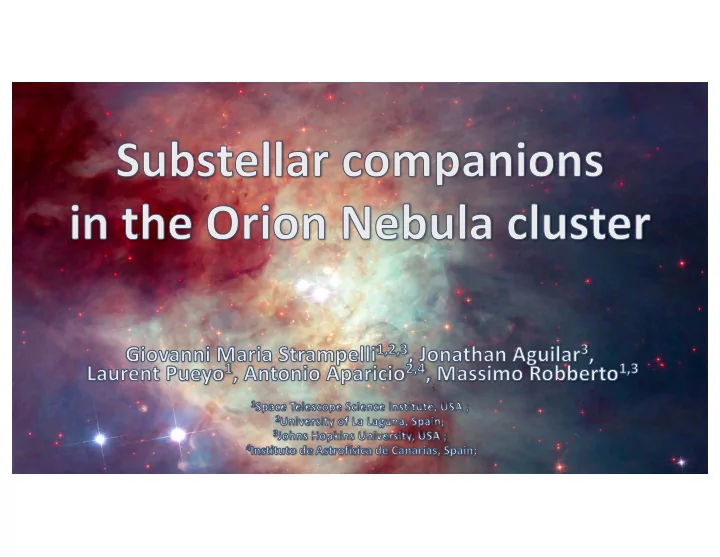

HST Treasury Program HST Treasury Program GO13826 (PI M.Robberto) WFC3 IR Data: • Target: Orion Nebula • 52 Visit • Area: ~ 1/6 th of square degree • Filters: F130N, F139M Robberto et al. 2019, submitted
The problem: galactic confusion at substellar masses Orion Nebula Cluster Orion Nebula Cluster Milky Way Milky Way Robberto et al. 2010, AJ 139, 950
Solution: Water in absorption feature WFC3 IR Channel: • F130N (red line) • F139M (blue line) Kirkpatrick, J. Davy 2005
CMD and cluster/background selection The chosen color index splits the low mass and substellar members of the Orion Nebula Cluster from the Galactic background Robberto et al 2019
CMD and cluster/background selection Cluster sources: • 10.9 ≤ mag 130 ≤ 22 • 3104 MULTIPLE VISITS targets • 2816 isolated targets (no stars ≤ 1.5'') Robberto et al 2019
Building the Local PSF • Each dot indicates the position of a point source on the detector (2816 isolated sources in our survey) • Detector area is divided in 10x10 quadrants of 102x102 pixels • Stars within a quadrant are grouped together for analysis
Building the Data Frame • WFC3 pixel scale = 0.13'' • 11x11 pixel postage stamp ( ~ 1.5''x1.5'')
Building the Data Frame • For each star, we use all other stars in the same quadrant to create a model PSF • Subtract the model PSF from the star using KLIP algorithm (Pueyo 2016)
Preliminary Catalog: Selection Criteria Outlier residual distributon as like a Normal distribution; • • ‘Minimum’ threshold selection to detect outliers defined by the sigma of the post- subtraction pixel histogram;
Preliminary Catalog: Selection Criteria 1. Presence of the detection in both filters 2. Persistance of the detection through different KLIP modes 3. Same position within 1 pixel (taking into account telescope rotation) more aggressive PSF subtraction
Photometry and mass estimate Photometric calibration: • primaries PSF photometry • 4 pixel aperture photometry for all primaries • conversion factor (Δ) between 4- pixel/PSF photometry to the photometry of the companions Companions magnitude errors sources: 𝑓𝑛𝑏 2 + 𝑓𝑡𝑙𝑧 2 + 𝑓∆ 2 2 2 emag + esky + e D Mass estimate:, • Comparison between de-reddend photometry and isochrone • AV from DaRio et al. 2016 and Robberto et al 2019
Candidate companions: Final Selections Control Sample: • MULTIPLE visit sources WHITOUT any candidate detection in it, considered as SINGLE visit
Candidate companions: Final Selections Control Sample: False Positive analysis: • MULTIPLE visit sources • any detection is a FP WHITOUT any candidate Moving threshold • FP ratio ≤ 1/10th of detection in it, considered expected signal as SINGLE visit
Candidate companions: Final Selections Control Sample: False Positive analysis: • MULTIPLE visit sources • any detection is a FP WHITOUT any candidate Moving threshold • FP ratio ≤ 1/10th of detection in it, considered expected signal as SINGLE visit New Catalog: • new thresholds aplied to the preliminary catalog
Candidate Companions: Contrast Curves Contrast curves for 50% completeness
Candidate Companions: Examples
Candidate Companions: Examples WFC3: ACS (Robberto et al 2013):
KLIP canididate detections
KLIP + Robberto et al 2019 WIDE binaries Blue: Robberto et al. 2019 binaries with separation ≤ 1.5'' Green: KLIP binaries with sepataion ≤ 1.5'' Binary fraction: 11.9% ± 0.8%
Completeness Curves Completeness (c) curves from fake-injection analysis. c ≥ 80 at projected sami major axis (SMA) ≥ 0.4 and masses: • M C ≥ 100 M J for primary masses M P ≥ 75 M J • M C ≥ 10 M J for primary masses 13 M J ≤ M P ≤ 75 M J
Spatial properties Close binaries Wide binaries Kolmogorov Smirnov test p-value > 0.1 Close binaries: separation ≤ 0.6'' Wide binaries: separation > 0.6''
Mass distribution Both distributions are compadible within the errors
Mass ratio
Mass Ratio Symbol Primary Mass circle M p ≥ 75 M J diamond 13 M J ≤ M p < 75 M J triangle M p < 13 M J
Summary • We have applied the KLIP PSF subtraction algorithm to a large dataset of wide- field HST images to uncover faint companions with separations between 0.17"- 0.78'' (70-314 AU) • We detect 67 companions with H 2 O in absorption Mostly complete (c ≥ 80%) at projected sami major axis ≥ 0.4 and masses: • • M C ≥ 100 M J for primary masses M P ≥ 75 M J • M C ≥ 10 M J for primary masses 13 M J ≤ M P ≤ 75 M J • ONC binary fraction = 11.9% ± 0.8%; • Mass ratio heavy tale with a median value of ~ 0.35 [M primary /M companion ];
Chance alignment
Recommend
More recommend